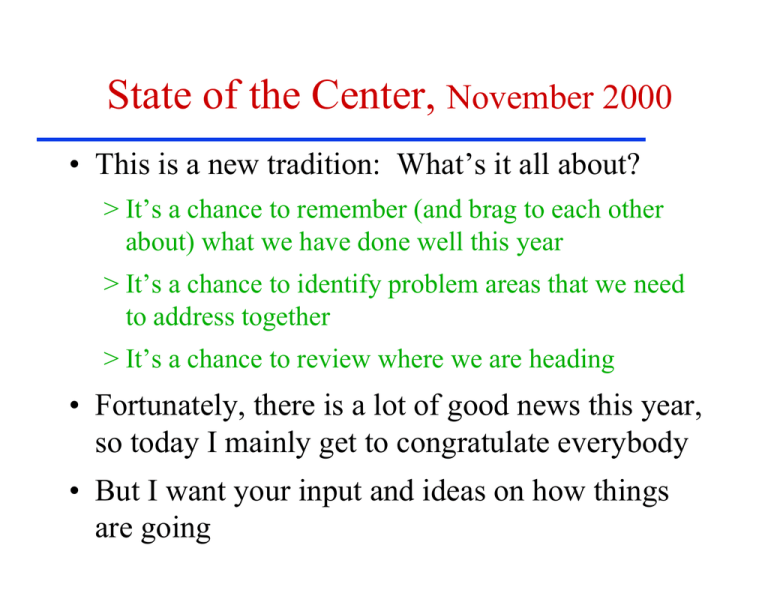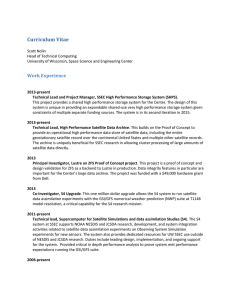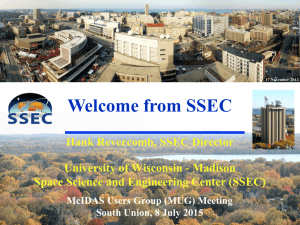State of the Center, November 2000
advertisement

State of the Center, November 2000 • This is a new tradition: What’s it all about? > It’s a chance to remember (and brag to each other about) what we have done well this year > It’s a chance to identify problem areas that we need to address together > It’s a chance to review where we are heading • Fortunately, there is a lot of good news this year, so today I mainly get to congratulate everybody • But I want your input and ideas on how things are going Let us know when you see something that’s not quite right Topics X Financial Health X Structural Status: How are our Center-level support structures working? X Review Year’s Events & Accomplishments X Vision: Where are we headed? Financial Health: It is Essential X James Buchanan Eades, bridge builder, said “Science can do anything, if given enough money” X I’d be leery of that claim, but it is clear that at SSEC we cannot do science without money Financial Health: Good & Getting Better X Last year we said ”We are a little down right now, but only a little bit, and we don’t plan to stay down” X Through your hard work, we have turned the corner and the trend is positive X New programs have definitely been an important factor--At this point our challenge has changed from needing more programs to needing more people to help get the work done SSEC Finances Net Cash Assets Millions $0.0 -$1.0 $0.0 Cash Balance -$1.0 -$2.0 May-99 -$2.0 Nov-99 May-00 Nov-00 Labor Percentage Billable 90.0% 80.0% Break Even (72%) 70.0% 60.0% 50.0% Nov-96 Nov-97 Nov-98 Nov-99 Structural Status: Significant Changes X SSEC Council is an invaluable source of sound advice and reason for setting Science Policy X Transition to a 3-Person Executive Directorship for implementing Science Policy was smooth: Many thanks to Bob Fox for his superior advice, assistance, and cooperation X Overhead Policy: Open reporting and review of overhead spending is in place. Members of SSEC can now apply to use overhead in ways that are good investments for the Center Initial SSEC Council Membership Faculty 1. Professor Steve A. Ackerman, Director of CIMSS Science Area Radiation/Clouds/Climate 2. Dr. W. Paul Menzel, Adjunct Professor, AOS & Senior Scientist of NOAA/NESDIS/ORA Operational Weather/ Climate 3. Professor Matt Hitchman, Chair AOS Upper trop/strat Climate 4. Professor Francis Halzen, Physics Ice Cube -Neutrinos 5. Professor John Valley, Geology and Geophysics SSEC Senior Academic Staff Geology Science Area 1. Dr. Henry E. Revercomb, SSEC Interim Director, Council Chair Remote Sensing, Earth & Other Planets 2. Dr. Lawrence A. Sromovsky, SSEC Senior Scientist Planetary Atmospheres 3. Dr. William L. Hibbard, SSEC Senior Scientist Visualization (VisAD,5D) 4. Dr. George R. Diak, SSEC Senior Scientist Agriculture/Surface/PBL 5. Dr. Edwin W. Eloranta, SSEC & AOS Senior Scientist LIDAR Clouds/Aerosols SSEC Science Component Observing Science (instrumentation, spacecraft system/mission design, field programs) Analytical Science (satellite and conventional data analysis and modeling) Computational and Visualization Science (Hardware & Software systems for information generation and communication) Externally Led Science (Physics, Astronomy, Botany, Geology …) 3-Person Executive Directorship X All Share their Administrative Roles with continued detailed involvement in programs – Exec. Director, Administration: John Roberts – Exec. Director, Science: Tom Achtor – Exec.Director, Technology: Fred Best X They, along with our in-house NOAA Team Leader, Elaine Prins, attend Council Meetings to exchange information & to foster implementation Structural Status X (Continued) The mutual benefit of a strong bond between the AOS Department and SSEC is recognized > Enhanced use of SSEC capabilities for using satellite data is being promoted in AOS > AOS and SSEC folks will appear together at our AMS booth this year X Challenges: > Recruiting more good people > Dealing with growth (increased from 189 to 215 this year) Year’s Events & Accomplishments X Continuing Broad-based Science & Applications X Major New Programs X Other Key Events X Awards and Kudos Broad-based Science & Applications (1) X MODIS: X Direct Launch December 18, 1999 X-band Downlink: August 2000 X GOES: New Products, Validation & 1st GOES-11 image 1 week from liftoff X OSEs (Observing System Expts) & Model Initialization X Hurricane Forecasting: Significant progress X VisAD Visualization: Its really Catching on MODIS: New Orleans, 2-24-00 (true color from 3 visible channels, 250 m) MODIS 2000/09/05-08 Daytime Total Ozone (Dobsons) EOS Direct Broadcast Groundstation TeraScan SX-EOS 4.4 m antenna: First data acquired 2000/08/18 Overpass prediction 2000/10/13 MODIS Direct Broadcast: Shenandoah Mountains, 1 Nov 2000 -RGB Color -250 meter resolution -Fire pixels (3.9 micron) overlaid Comparison of GOES-8 PW with microwave retrievals Co-located total precipitable water (PW) values retrieved from the GOES Sounder compare well with integrated moisture measured by a microwave radiometer at the CART site (Lamont, OK). Note “flat” first-guess trace. GOES retrievals show ability to capture the trend and range of total moisture. Data Impact Studies Comparison of denying RAOB or Satellite Data to ETA Data Assimilation System Ratio >1 Satellite wins! Ratio A. 24-HR Temperature Ratio (NOSAT/NORAOB) 5 4 3 2 1 0 300 hPa 500 hPa 700 hPa 850 hPa DEC APR JUL 1000 hPa Season Ratio B. 24-HR Rel. Humidity Ratio (NOSAT/NORAOB) 7 6 5 4 3 2 1 0 300 hPa 500 hPa 700 hPa 850 hPa DEC APR Season JUL 1000 hPa New 3-D Cloud Water Initializer using GOES Both use Cloud top P from GOES Sounder Old method gives one Cloud per column New Max/Min-Pressure Method gives 2 cloud layers from bimodal distribution R. Aune, NESDIS/ORA Hurricanes & Satellite Derived Winds Super Rapid-Scan Winds Proven BAMS: “Satellite data … have led to a steady decrease in track forecast errors” New GOES Wind Shear product Tasmania from Australia BoM •Australian Bureau of Met using VisAD •Unidata recently released their METAPPS package based on VisAD •NCAR will soon release VMET based on VisAD •NCSA Portal Architecture using VisAD Broad-based Science & Applications (2) X Planetary Science: observing and instrument development X Lidar-based X Major science field programs – WISC T2000 (NASA ER2 in Madison) – SAFARI in South Africa – WVIOP/AFWEX in Oklahoma X Biomass Burning SSEC Research on Planetary Atmospheres: overview Participants: Sromovsky, Fry, Limaye Current Targets: Neptune Uranus Jupiter Objectives: Circulation Cloud Structure Composition Tools: In situ and remote Imaging and Spectroscopy Data sources: Groundbased Telescopes, Hubble Space Telescope, Galileo 1 Nov 99 Imaging of Downtown Madison, WI 2200 cm-1 2350 cm-1 2500 cm-1 SAFARI: South Africa with Scanning HIS Ralph, what are we doing here? Did you see Elaine’s Fire images from the US? Biomass burning in the Western US 22 August 2000 Wildfire Automated composite, 22:15 UTC GOES Visible Image, 23:30 UTC Broad-based Science & Applications (3) X AERI for now-casting X RESAC (Regional Earth Science Applications Center): Data & Modeling for Agriculture, Water, & Forestry X Iceberg formation & evolution: AMRC (Antarctic Meteorological Research Center) X VISIT view: Java-based Remote training sessions with NWS and other meteorologists AERI SYSTEMS AROUND THE WORLD UW AERI - 2 (AERIBAGO, SSEC) DOE AERI - 7 (Kansas/Oklahoma, Alaska, S. Pacific) U-Miami M-AERI - 3 (Florida) Bomem AERI - 4 (Italy, California, Maryland, Canada) U Idaho P-AERI - 1 (Antarctica) Data Landsat Conventional GOES Vis & Thermal Aircraft Penetrometer IKONOS EM38 NEXRAD Topography, soil properties, etc. Rillmeter MODIS AVHRR Icebergs in the News: Limbert Automated Weather Station Spared Major new Programs X GIFTS (Geostationary Imaging FT Spectrometer): 1999 Holiday Present X CIRRUS: Study Report due 2/15/2001 X Ice Coring and Drilling Services (ICDS): SSEC is now home to this service for NSF X IceCube: The venture to map the highest energy sources in the universe is getting real X Joule: Re-fly of X-ray experiment for ASTRO-E GIFTS: The Next Major Advance in Observing from Geostationary Orbit 16,000 Temperature, Humidity & Trace Gas Profiles in 10 sec Dense Wind Observations, tracked from Water Vapor Sdgs Global Sounding in < 10 min High resolution Sounding of 6000 x 6000 km in < 30 min Cloud InfraRed Radiometer for UnesS (CIRRUS) Antarctic Astronomy & Astrophysics Research Institute X AMANDA Antarctic Muon and Neutrino Detector Array X IceCube Expand to 1 km3 X Ice Coring & Drilling Services Ice Coring & Drilling Services X World-wide support for ice coring & drilling projects (Antarctica, Greenland, Tibet), including new drill development X Charles Bentley, Geology, PI X SSEC Impact – 7 Permanent Staff, 4-25 seasonal additions – 3 year Contract, plus 2 year option IceCube, the Neutrino telescope 1 km3 detector buried up to 2.5 km in the South Pole ice observes neutrinos from astrophysical sources & Earth’s atmosphere X SSEC is playing a lead role in management and engineering X – ~10 new people at SSEC – Official start in October 2001, planning and engineering has begun X-ray observations of extended sources Selected! UW Adiabatic Demagnitization Refrigerator in Helium Dewar Other Key Events SSEC Office of Space Science Education successes (Rose Pertzborn to serve at NASA Hdq) X More McIDAS Impact: X – Hurricanes Georges & Bertha for the Discovery Channel – GOES to Grand Canyon Parks Service for Fire Fighting Future Fair—Monona Terrace X SSEC Library exhibit of 1st snow crystal photos X Open house—Good support for a new building tradition X SSEC Dane-o-meter countdown to a record career X Think UW-Madison X Office of Space Science Education - Highlights GIFTS Education & Public Outreach Program for Water Vapor Special Measurement through GLOBE (NASA/NOAA/EPA) GLOBE Training for Teachers - Chiwaukee Academy and Madison Schools GET-WISE: Geoscience Distance Learning Program for Science Teachers ESCAPE - Web Based Learning Program funded by NASA/Earth Science Enterprise PEOPLE, Future Fair, Campus Open House, UW-Madison Speakers Bureau & Other Presentations in LaCrosse, Racine, Mt. Horeb, Madison, Chicago, Milwaukee EPO Programs Proposed for: • ICE-Cube • VESAT • OPUS • HIMS • CIRRUS • ROSS • BIOME / NASA • JOULE Future Fair, 4-5 Dec 1999, Monona Terrace Convention Center, Madison Awards/Kudos (1) Don Johnson: named a fellow of the Amer. Assoc. for the Advancement of Science X Francis Bretherton: named a fellow of the Amer. Assoc. for the Advancement of Science X Grace Wahba (statistician who works with Don Johnson’s group): named to the National Academy of Science X Tom Haig (SSEC Executive Director 1970-80): Pioneer who led the development of the polar orbiting meteorological satellite system X Awards/Kudos (2) Tim Schmit: Silver Medal from the US Dept. of Commerce for GOES product development X CIMSS NOAA employees: Bronze medals for their work this year X Chris Velden, Tim Olander, Steve Wanzong: Banner Miller Award for papers on hurricane forecasting X Chuck Stearns & Group: Automatic Weather Stations-USA today, Susan Solomon X McIDAS Team: Kudos for excellent MUG Mtg X Vision of our Future X Advancing Earth Systems Science, Weather, and Climate with New Observing, Retrieval Science, Computer & Modeling Techniques: – We have been doing things that should prepare us well for the future, & help determine the future of our field – We need to put more emphasis on Microwave Observations and Data Assimilation X High Spectral Resolution and Many Channel Imagers are here to stay AIRS/ CrIS / IASI, GIFTS / ABS, & MODIS/VIRS X The Tidal Wave of Data on the horizon should drive us to develop new ways to find the messages Vision of our Future (2) X New Science Areas (A3RI//ICDS/IceCube) offer exciting challenges and rewards X A New Discover mission for Planetary Research, like VESAT or OPUS, would add still more excitement Committed to keeping our Key Traditional Segments of SSEC Strong X McIDAS+VisAD+Data Center+GOES Archive Data access and visualization of the world, for the world X Space Flight Hardware Design and Fabrication Providing fundamentally new views of the world: From new Earth Science, to Operational Instrument Advances, to Planetary Exploration, and to Astronomy X Cooperative Institute for Meteorological Satellite Studies (CIMSS) Leaders in multi-spectral remote sensing for clouds, winds, atmospheric state, surface properties and observing system experiments that impact plans for future satellite systems


